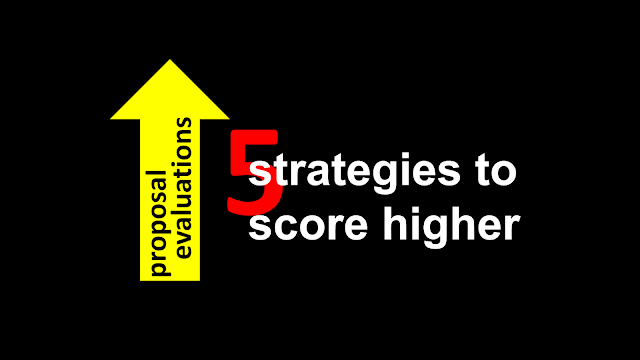Proposal Evaluations: Five Strategies to Score Higher
As we enter a new proposal season, many of us are looking to
find ways to improve our proposals and win more. As we look for areas to focus
our improvement efforts, it’s helpful to remember that in the vast majority of
cases, proposals are scored, not read. Therefore, as bidders looking to win
work, to maximize proposal performance, we should aim to help evaluators award
us as many points as possible. This article presents five easy ways to focus
your content so that it scores higher.
1. Take Time to
Understand the Customer
The first real step to scoring higher is understanding your
customers and their needs—and it is critical to take the time to understand the
customer needs before the RFP is
released. Remember that building a relationship with your customers and
understanding their underlying concerns takes time. Without solid customer
relationships, you won’t have the opportunity to understand their programmatic
concerns or determine what really keeps them up at night.
2. Define the Value
Proposition
Another critical step in scoring higher is defining your
value proposition. The value proposition summarizes the case for why your
company should be awarded the contract—it is the rationale or justification for
winning. When developing your value proposition, you should start with the
information the government needs to justify selecting your company, and then
give the evaluators the key points they can highlight, quantifying where
possible. Defining this value proposition is extremely difficult when you don’t
understand the customer and their needs—that’s why it’s so critical to start
early and gain the necessary customer insights.
3. Document the Hot
Buttons and Win Themes
A third critical step in scoring higher is documenting the
hot buttons and win themes. This helps the writing team to understand what the
customer cares about. When the writing team doesn’t have a list of customer hot
buttons and win themes before the RFP is released, the first drafts must
default to generic approaches that won’t necessarily resonate with the customer.
Going back to retrofit narrative to address customer hot buttons and weave in
win themes takes so much more time than writing to them in the first place. In
addition, this delayed approach often results in awkward flow and stilted
content. Identifying hot buttons and win themes early enables the team to
develop approaches that directly address the customer’s concerns and highlight
the strengths of the team. This supports stronger content from the beginning,
saving time and resulting in higher quality final proposal content that will
ultimately score higher in the end.
4. Focus on the
Customer
Another critical way to score higher is to make sure you are
focusing on the customer. Remember, proposals should be about how the
customer’s needs are met by your solution, not about how wonderful your company
is and why the customer should choose you. To determine whether your writing is
more company-focused or customer focused, try this quick test. Hit Ctrl-F and
search for the number of times you mention your company and/or team name. Then
search for the number of times you mention the customer’s name. You should aim
to mention the customer’s name more time than yours. If you don’t, go back and
revise your text to focus more on the customer and the benefits they will
receive by choosing your solution.
5. Organize Content So
It’s Easy to Score
A final way to maximize your scoring potential is to present
your content in a way that is easy to score. To make your sections easy to
score, structure your response to the Proposal Instructions and the Evaluation
Criteria. Next map in other requirements, as required. To facilitate
evaluation, consider including relevant RFP references in your section heading
titles. Additionally, evaluators often do key word searches to find what’s
important to them. Make sure all sections include key words from the instructions,
evaluation criteria, and the SOW. To make your proposal narrative even more
evaluator-friendly, leverage feature and benefit tables and highlight strong proof
points using callout boxes.
Final Thoughts
Remember, to score higher and win more, the first real step
is understanding your customers and their needs. Leveraging this knowledge,
you’ll want to develop and document your value proposition, customer hot
buttons, and win themes. Finally, as you develop your proposal text, make sure
you focus the response on the customer and organize the content so that it is
easy to score. These five simple components can go a long way in facilitating
the evaluation process and increasing your overall score—and a higher score can
easily translate to a higher probability of win!
Written by Ashley (Kayes) Floro, CPP APMP
Senior Consultant and President
Proptimal Solutions, LLC
proptimalsolutions.com
LinkedIn
Senior Consultant and President
Proptimal Solutions, LLC
proptimalsolutions.com





Comments
Post a Comment